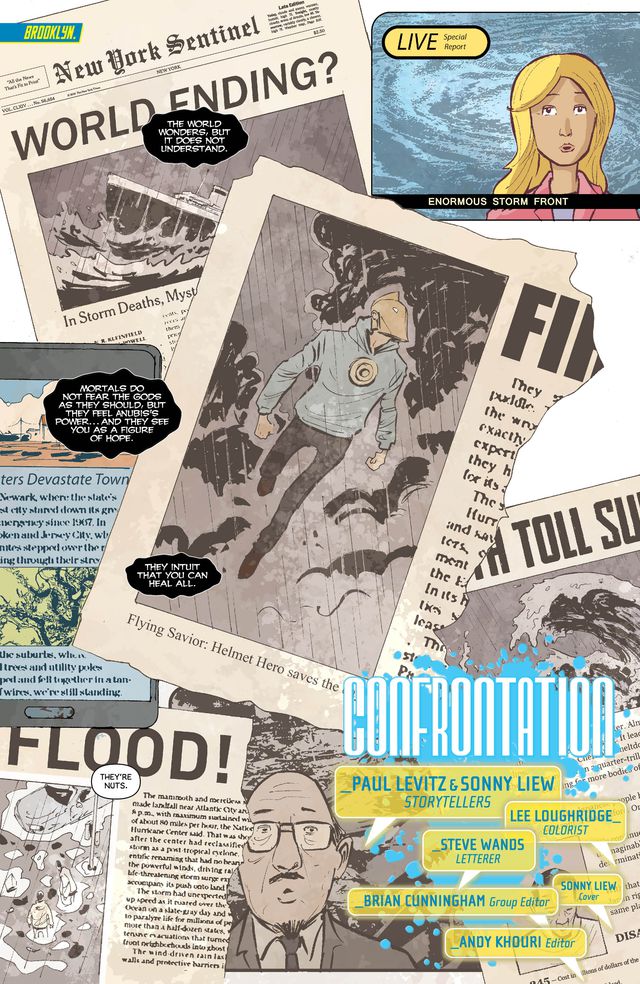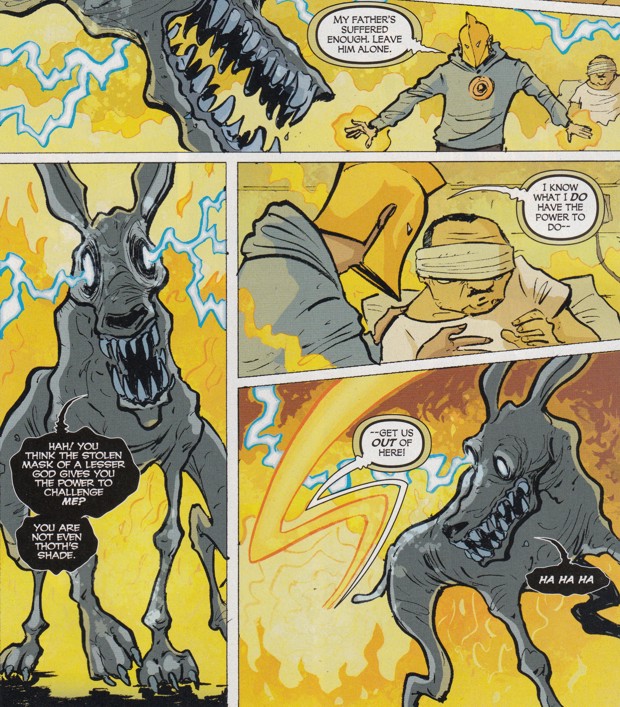Dr. Fate #5 Review
"The Fate of the World"
A few months ago, DC Comics began a new series centering on the mystic character Dr. Fate, though this was a far more unusual take on the character. This Dr. Fate is young, of mixed ancestry, and ambivalent about the helmet of Nabu. The most unconventional part of this series might be its storytelling, though it’s also a big draw.
Dr. Fate #5 suffers a little from repetition, but it is a mostly solid issue of a promising series. Warning, there are
SPOILERS for this issue and the previous issues of
Dr. Fate.

The premise of this version of Dr. Fate is that Khalid Nassour, son of an immigrant Egyptian father and an American Caucasian mother, is starting medical school in New York City when he is summoned by the god Toth to fight against the god Anubis, who is seeking to eradicate humans. Khalid spends much of the first few issues trying to comprehend, believe and master his new powers. Meanwhile, Anubis attacks Khalid’s father, blinding him. At the conclusion of
Dr. Fate #5, Khalid agrees to deal with Anubis, a terrible idea that restores his father’s vision but takes Khalid’s.
The new
Dr. Fate is a part of the “DC You” mini-line that DC started in the past year, attempting to offer smaller and more diverse stories. The writer on this series is Paul Levitz, and he seems like an odd choice at first for an unconventional series about Dr. Fate since Levitz is an old-school writer (and former Editor-in-Chief), perhaps best known for his runs on
Legion of Superheroes. Still, Levitz actually does a very nice job writing a “small” version of Dr. Fate, and is surprisingly facile at handling the dialogue of all the characters, including Khalid's friends and family.

However, it is the art of Sonny Liew that is probably the most unusual elements of the series. Liew’s art is very individualistic, with a sinewy and cartoonish look. It’s not your prototypical super-hero art, but it’s still innovative and strong in design elements. Liew’s storytelling instincts are also effective in spite of his rather peculiar style. While this Dr. Fate may not look the most heroic (he often doesn’t have a costume), the action sequences on
Dr. Fate, including a confrontation with Anubis in
Dr. Fate #5, are exciting.
Dr. Fate does not require much knowledge of the legacy of the Golden Age hero (who for much of the Modern Age was an Earth 2 hero with the Justice Society of America). As such, it is a very approachable series that would appeal to readers of many sorts of comics. Ultimately, a reader’s appreciation of
Dr. Fate will come down to his/her opinion of Liew’s artwork, as it will probably not be to the taste of all fans.
 Dr. Fate
Dr. Fate is not without its problems, and those are very evident in
Dr. Fate #5. The biggest drawback so far is that Levitz and Liew have been establishing Khalid as a reluctant hero, one who is trying to understand his capabilities and the situation around him. In one sense, this does make Khalid relatable. However, this leads to some repetitiveness as he again offers questions like “Why me?” and “Is this even real?” It’s some of the problems that many origin stories face, as readers eventually want the main character to just accept the hero mantle rather than fight it the whole time. So while the slow development of Fate is understandable, it’s a little exasperating at times.
Dr. Fate is not a series that is going to be near the top sellers, nor is it intended to be. The character isn’t especially popular and die-hard Golden Age/Earth 2 fans might be turned off by this younger, costume-less Fate. Still, it feels like the type of series that could generate a loyal following if readers give it a chance.
Dr. Fate #5 ends with a dramatic cliffhanger, with Khalid blinded, meaning that big changes could be coming to the still-establishing character and series.
Pros
- A character-based story
- Levitz does a good job revealing Khalid's personality
- Liew's artwork is unusual but very striking
Cons
- Khalid's reluctance leads to some repetitiveness
- The story could move more swiftly at times
 The premise of this version of Dr. Fate is that Khalid Nassour, son of an immigrant Egyptian father and an American Caucasian mother, is starting medical school in New York City when he is summoned by the god Toth to fight against the god Anubis, who is seeking to eradicate humans. Khalid spends much of the first few issues trying to comprehend, believe and master his new powers. Meanwhile, Anubis attacks Khalid’s father, blinding him. At the conclusion of Dr. Fate #5, Khalid agrees to deal with Anubis, a terrible idea that restores his father’s vision but takes Khalid’s.
The new Dr. Fate is a part of the “DC You” mini-line that DC started in the past year, attempting to offer smaller and more diverse stories. The writer on this series is Paul Levitz, and he seems like an odd choice at first for an unconventional series about Dr. Fate since Levitz is an old-school writer (and former Editor-in-Chief), perhaps best known for his runs on Legion of Superheroes. Still, Levitz actually does a very nice job writing a “small” version of Dr. Fate, and is surprisingly facile at handling the dialogue of all the characters, including Khalid's friends and family.
The premise of this version of Dr. Fate is that Khalid Nassour, son of an immigrant Egyptian father and an American Caucasian mother, is starting medical school in New York City when he is summoned by the god Toth to fight against the god Anubis, who is seeking to eradicate humans. Khalid spends much of the first few issues trying to comprehend, believe and master his new powers. Meanwhile, Anubis attacks Khalid’s father, blinding him. At the conclusion of Dr. Fate #5, Khalid agrees to deal with Anubis, a terrible idea that restores his father’s vision but takes Khalid’s.
The new Dr. Fate is a part of the “DC You” mini-line that DC started in the past year, attempting to offer smaller and more diverse stories. The writer on this series is Paul Levitz, and he seems like an odd choice at first for an unconventional series about Dr. Fate since Levitz is an old-school writer (and former Editor-in-Chief), perhaps best known for his runs on Legion of Superheroes. Still, Levitz actually does a very nice job writing a “small” version of Dr. Fate, and is surprisingly facile at handling the dialogue of all the characters, including Khalid's friends and family.
 However, it is the art of Sonny Liew that is probably the most unusual elements of the series. Liew’s art is very individualistic, with a sinewy and cartoonish look. It’s not your prototypical super-hero art, but it’s still innovative and strong in design elements. Liew’s storytelling instincts are also effective in spite of his rather peculiar style. While this Dr. Fate may not look the most heroic (he often doesn’t have a costume), the action sequences on Dr. Fate, including a confrontation with Anubis in Dr. Fate #5, are exciting.
Dr. Fate does not require much knowledge of the legacy of the Golden Age hero (who for much of the Modern Age was an Earth 2 hero with the Justice Society of America). As such, it is a very approachable series that would appeal to readers of many sorts of comics. Ultimately, a reader’s appreciation of Dr. Fate will come down to his/her opinion of Liew’s artwork, as it will probably not be to the taste of all fans.
However, it is the art of Sonny Liew that is probably the most unusual elements of the series. Liew’s art is very individualistic, with a sinewy and cartoonish look. It’s not your prototypical super-hero art, but it’s still innovative and strong in design elements. Liew’s storytelling instincts are also effective in spite of his rather peculiar style. While this Dr. Fate may not look the most heroic (he often doesn’t have a costume), the action sequences on Dr. Fate, including a confrontation with Anubis in Dr. Fate #5, are exciting.
Dr. Fate does not require much knowledge of the legacy of the Golden Age hero (who for much of the Modern Age was an Earth 2 hero with the Justice Society of America). As such, it is a very approachable series that would appeal to readers of many sorts of comics. Ultimately, a reader’s appreciation of Dr. Fate will come down to his/her opinion of Liew’s artwork, as it will probably not be to the taste of all fans.
 Dr. Fate is not without its problems, and those are very evident in Dr. Fate #5. The biggest drawback so far is that Levitz and Liew have been establishing Khalid as a reluctant hero, one who is trying to understand his capabilities and the situation around him. In one sense, this does make Khalid relatable. However, this leads to some repetitiveness as he again offers questions like “Why me?” and “Is this even real?” It’s some of the problems that many origin stories face, as readers eventually want the main character to just accept the hero mantle rather than fight it the whole time. So while the slow development of Fate is understandable, it’s a little exasperating at times.
Dr. Fate is not a series that is going to be near the top sellers, nor is it intended to be. The character isn’t especially popular and die-hard Golden Age/Earth 2 fans might be turned off by this younger, costume-less Fate. Still, it feels like the type of series that could generate a loyal following if readers give it a chance. Dr. Fate #5 ends with a dramatic cliffhanger, with Khalid blinded, meaning that big changes could be coming to the still-establishing character and series.
Dr. Fate is not without its problems, and those are very evident in Dr. Fate #5. The biggest drawback so far is that Levitz and Liew have been establishing Khalid as a reluctant hero, one who is trying to understand his capabilities and the situation around him. In one sense, this does make Khalid relatable. However, this leads to some repetitiveness as he again offers questions like “Why me?” and “Is this even real?” It’s some of the problems that many origin stories face, as readers eventually want the main character to just accept the hero mantle rather than fight it the whole time. So while the slow development of Fate is understandable, it’s a little exasperating at times.
Dr. Fate is not a series that is going to be near the top sellers, nor is it intended to be. The character isn’t especially popular and die-hard Golden Age/Earth 2 fans might be turned off by this younger, costume-less Fate. Still, it feels like the type of series that could generate a loyal following if readers give it a chance. Dr. Fate #5 ends with a dramatic cliffhanger, with Khalid blinded, meaning that big changes could be coming to the still-establishing character and series.